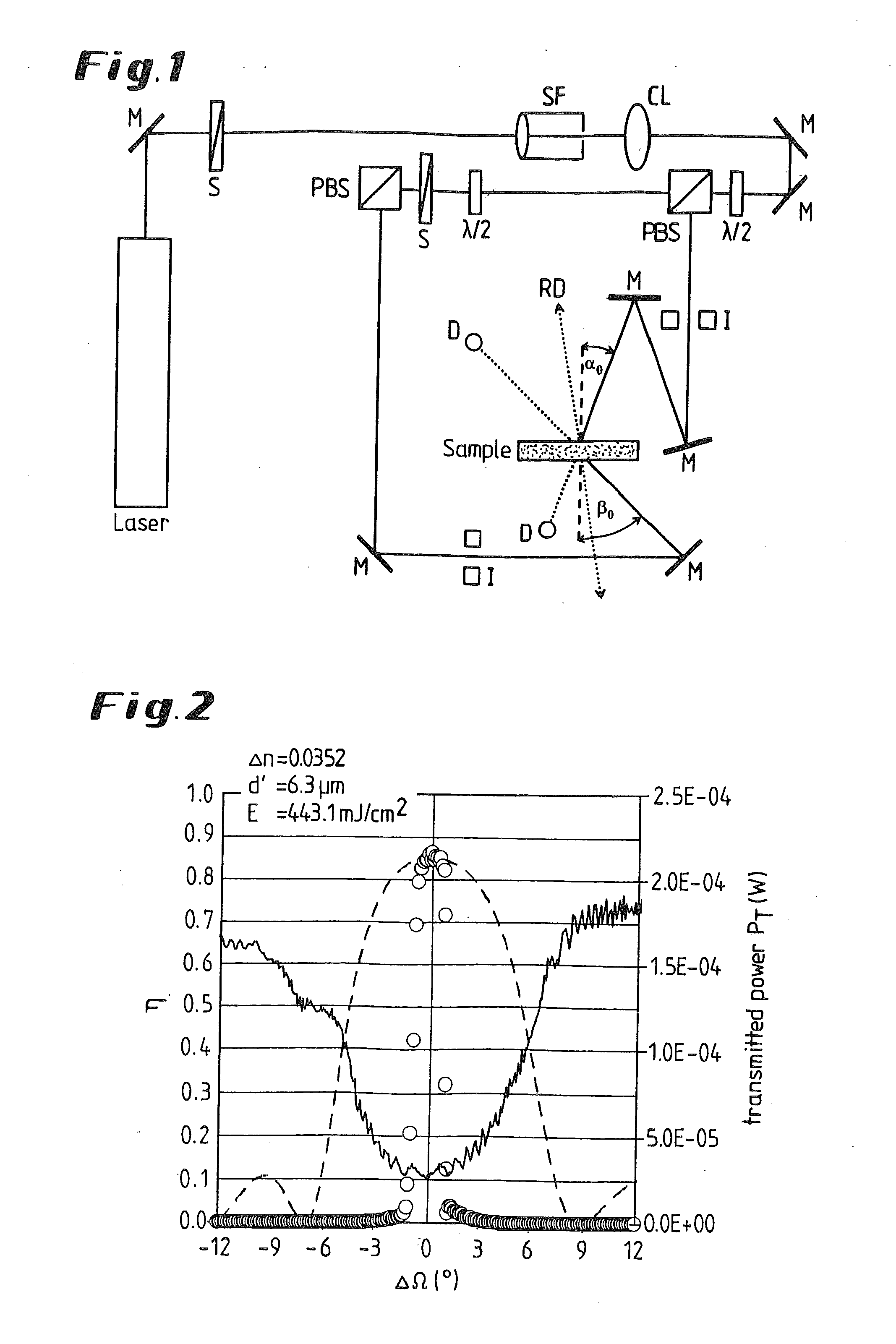Photopolymer formulation for producing visible holograms
a technology of photopolymer and hologram, which is applied in the field of photopolymer formulation, can solve the problems of difficult or impossible to see holograms with the naked ey
- Summary
- Abstract
- Description
- Claims
- Application Information
AI Technical Summary
Problems solved by technology
Method used
Image
Examples
examples
[0138]The examples which follow illustrate certain embodiments of the invention.
Starting Materials:
[0139]Isocyanate component 1 is a product of Bayer MaterialScience AG, Leverkusen, Germany, full allophanate of hexane diisocyanate on polypropylene glycol having a number average molar mass of about 280 g / mol, NCO content: 16.5-17.3%.
[0140]Polyol 1 is an experimental product of Bayer MaterialScience AG, Leverkusen, Germany, the preparation is described below.
[0141]DMC catalyst: double metal cyanide catalyst based on zinc hexacyanocobaltate (III), obtainable by the process described in EP-A 700 949.
[0142]Irganox 1076 is octadecyl 3,5-di-(tert)-butyl-4-hydroxyhydrocinnamate (CAS 2082-79-3).
[0143]Acrylate 1 is an experimental product of Bayer MaterialScience AG, Leverkusen, Germany, the preparation is described below.
[0144]Acrylate 2 is an experimental product of Bayer MaterialScience AG, Leverkusen, Germany, the preparation is described below.
[0145]Additive 1 is an experimental product ...
example medium 1
[0188]2.00 g of acrylate 1, 2.00 g of acrylate 2, 1.50 g of additive 1 were dissolved in 2.907 g of polyol 1 at 60° C. Then, 0.18 g of coinitiator 2 and 0.015 g of glass beads 10 μm in diameter were added. A solution of 0.03 g of coinitiator 1 and 0.015 g of dye 1 was mixed into 1.492 g of N-ethylpyrilidone in the dark to obtain a clear solution. The polyol solution described above was mixed in the dark with the just-described solution at about 35° C. This was followed by cooling to 30° C., addition of 0.367 g of isocyanate component 1 and 0.006 g of catalyst 1 and renewed mixing. The liquid mass obtained was then applied to a glass plate and there covered with a second glass plate, which was kept at a distance of 10 μm by the glass beads. This sample specimen was left to lie at room temperature and cured for 16 hours.
example medium 2
[0189]100 g of acrylate 1, 2.00 g of acrylate 2, 1.50 g of additive 1 were dissolved in 2.907 g of polyol 1 at 60° C. Then, 0.02 g of coinitiator 2 and 0.015 g of glass beads 10 μm in diameter were added. A solution of 0.27 g of coinitiator 1 and 0,015 g of dye 1 was mixed into 1.492 g of N-ethylpyrilidone in the dark to obtain a clear solution. The polyol solution described above was mixed in the dark with the just-described solution at about 35° C. This was followed by cooling to 30° C., addition of 0.367 g of isocyanate component 1 and 0.006 g of catalyst 1 and renewed mixing. The liquid mass obtained was then applied to a glass plate and there covered with a second glass plate, which was kept at a distance of 10 μm by the glass beads. This sample specimen was left to lie at room temperature and cured for 16 hours.
PUM
| Property | Measurement | Unit |
|---|---|---|
| number average molar masses | aaaaa | aaaaa |
| number average molar masses | aaaaa | aaaaa |
| number average molar masses | aaaaa | aaaaa |
Abstract
Description
Claims
Application Information
 Login to View More
Login to View More - R&D
- Intellectual Property
- Life Sciences
- Materials
- Tech Scout
- Unparalleled Data Quality
- Higher Quality Content
- 60% Fewer Hallucinations
Browse by: Latest US Patents, China's latest patents, Technical Efficacy Thesaurus, Application Domain, Technology Topic, Popular Technical Reports.
© 2025 PatSnap. All rights reserved.Legal|Privacy policy|Modern Slavery Act Transparency Statement|Sitemap|About US| Contact US: help@patsnap.com



